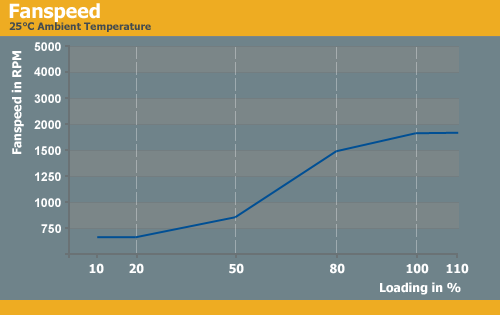Thermaltake TR2 QFan Series
by Christoph Katzer on November 19, 2008 3:00 AM EST- Posted in
- Cases/Cooling/PSUs
Temperatures, Fan Speed, and Acoustics

Both primary heatsinks hold stable at up to 40°C throughout testing, only surpassing that threshold when we overload the power supply. It's also nice to see that temperatures immediately decrease once the fan starts spinning faster. Of course we need to keep in mind that the heatsinks and fan don't need to deal with nearly as much heat, since these are only 300W to 450W PSUs. That's one of the benefits of using a smaller power supply.
We have previously commented that we didn't like the standard CWT heatsink design, with their "umbrella" fins blocking airflow and failing to dissipate heat as well as we would like. This time, due to less produced heat and a desire to cut costs, CWT used smaller heatsinks and the different temperature results are immediately visible. The only complaint we have is with the third heatsink; it should be larger, since even at room temperature it reaches up to 80°C.

The fan spins at a very tame 650RPM for the first couple loading stages. Once we reach 50% load, fan speed quickly begins to ramp up and is at 1500RPM with 80% load. The good news is that the heatsinks immediately get cooler, but the drawback is increased noise output. With a slightly better heatsink design and improved fan speed control, it should be possible to keep temperatures and noise levels down.

The acoustic noise develops fast with increasing fan speed. Going from 650RPM to 1500RPM brings a nice fat 10dB(A) increase in noise, which is not very good. The maximum noise output of 33dB(A) is unfortunately very loud. We strongly recommend that users interested in keeping noise levels down try to stay under 50% of the rated PSU output.










36 Comments
View All Comments
CEO Ballmer - Wednesday, November 19, 2008 - link
I like this, I'll have to try a few hundred!http://fakesteveballmer.blogspot.com">http://fakesteveballmer.blogspot.com
JonnyDough - Thursday, November 20, 2008 - link
Can you ban this user's IP please? He keeps spamming over at Tom's Hardware also.strikeback03 - Friday, November 21, 2008 - link
If they want to keep spamming, they can just get a new IP.phreax9802 - Wednesday, November 19, 2008 - link
Only one 6-pin PEG connector? Come on..this is 2008! My old Enermax FMA II 460W has two of them..fic2 - Wednesday, November 19, 2008 - link
You measured that the secondary heat sink temp reached 80 degrees. How hard would it be for a user to replace the secondary with a larger heat sink? How hard would it be to find an appropriate heat sink for this? I looked on the internals pictures but couldn't find anything that I thought looked like a heat sink except maybe what looked like separator walls.ggathagan - Wednesday, November 19, 2008 - link
Regardless of how hard or easy it is, replacing the heatsink would void the warranty.It also misses the point: The manufacturer should be supplying the appropriate heatsink in a properly designed PSU. If they don't, why should I buy it?
sam187 - Wednesday, November 19, 2008 - link
Hallo Christoph,danke fuer deine ausfuehrlichen Reviews auch mal aus der Heimat ;-)
First, it would be nice to see a comparison in the 300-500W range. Next to that, please take a look at things like the picoPSU. Are they that much more efficient than normal psus and do they meet the demands for current htpc platforms (g45/780g/nv9300 with a small cpu)?
Sascha
Hamburg, Germany
haplo602 - Wednesday, November 19, 2008 - link
Thanks for the review. I'd like to see some more 350W and 450W PSUs.xaris106 - Wednesday, November 19, 2008 - link
I also think its great to review "low" wattage models. It's the biggest portion of the market, as you say in your articles, an I aggree. So thanks for reviewing this and i also hope you continue with this range of wattages. We all know that buying a high end high power model from a good brand, we will propably get a quality psu. But not so in the 300-500W range.What I would like to see is:
1) Step load tests: I would like to see how each psu handles load changes (eg a sudden 1A change). The voltage overshoots, settling times can give a lot more information about the quality of a psu.
In other words..transient response tests.
2)A review, maybe as reference of an as cheap as it gets no name psu, to see what we get more with our money spent on brand name psu.
Thanks.
Boushh - Wednesday, November 19, 2008 - link
What I would like to see is good quality sub 400 Watt modulair power supply's. These are (almost ?) impossible to find.It's a miss calculation from the manufactures that people will not pay more for these units. Many people who employ sub 400 watt units do this because they don't need more, and because it will have to fit into a smaller case. Then all those cables are just in the way, because they will not be used.
Further more (as suggested in to article) using high quality design and materials will give better power supply's. Sure they will cost more, but I'll gladly pay that if some manufacturer would build them.
And I don't think I'm alone in this. So please manufactures, start listning to your customers !!!!!